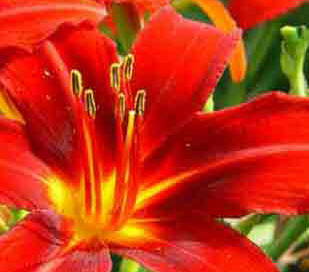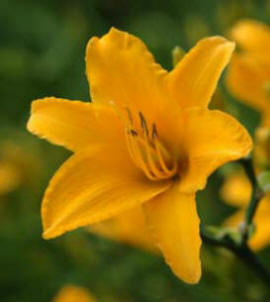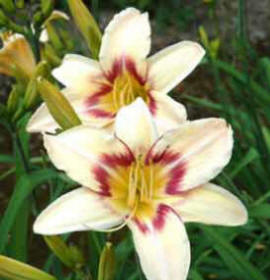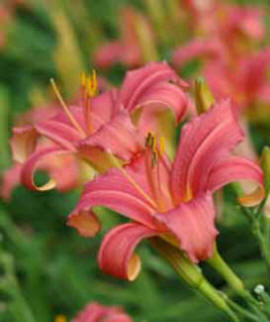Hemerocallis - DayLily
If first impressions really do count, then the Hemerocallis is best grown in damp soil. This, because when I first met the Hemerocallis in a drift worth noting, it was at the side of a big pond, and in very moist - sometime boggy ground. However, over the years, I have seen Hemerocallis growing as well in dry conditions with full sun, and also to a slightly lesser extent in dappled shade of woodlands.
The common name of Daylily is well deserved - though not flattering - for each bloom only lasts for a single day. No matter! A decent plant will have many blooms in succession - starting in mid-June and then finally fading in late summer - autumn even.
The Daylily is evergreen or a mostly semi-evergreen hardy perennial, but you would not want to plant it simply because of that. The foliage that remains in winter is at best, a little untidy. The leaves - which form quite a clump - are strappy/grass shaped, arching over to touch the ground in many cases.
 Some are fully herbaceous, dying down to ground
level and then re-emerging in the spring. The 'evergreen' ones are more
floriferous I have found.
Some are fully herbaceous, dying down to ground
level and then re-emerging in the spring. The 'evergreen' ones are more
floriferous I have found.
The individual flowers are normally flared trumpet to bell-shaped, and are available in many different shades of yellow, cream, orange, maroon and some are bi-coloured by way of having a yellow throat behind the darker outer petals. The flowers either 'nest' at the top of the foliage clump, or are held above on single stemmed but then top branched clusters of buds and flowers.
There are a few different flower shapes - or forms, ranging from the tight trumpet to an open six-petalled bell. Stay with the flared trumpets for a good show! (I have musician friends who would wholeheartedly agree!)
The image is of Hemerocallis Orange Rust.
About Hemerocallis
Hemerocallis used to be a member of the Lily family (Liliaceae) but as botany moves forward, is is now in the Xanthorrhoeaceae family - but having its own division within.
Hemerocallis is a VERY easy to grow hardy perennial. Basically, you could simply plant it and forget all about it. But, it would deteriorate over the years, so we outline care treatment below - nothing too arduous.
Dependent upon variety, the Daylily will grow (foliage clump) to 60-80cm tall, with flower spikes over the top of that to around combined height of 90cm. The spread of the actual above-ground plant canopy, will be similar to the height after 2 years. (There are dwarf varieties that are half that size.)
They seem always eager to please and look after themselves, and in that respect make good groundcover plants. Some varieties are rhizomatous and spread quicker - and further - than the clump-forming types. A cluster of a few plants really is impenetrable for most weeds. But, they also make for a solitary colourful specimen plant in a lawn bed.
My experience would suggest that they will grow more or less anywhere - once established! Full sun is ideal, but partial shade can also be coped with. I have also seen them put on a reasonable display in a woodland garden.
There are a huge range of hybrids of this popular plant, so the main thing is to try to see your container plant in flower, so that you can be sure of what you are getting - or order from a specialist nursery.
NB Some varieties open late afternoon and then flower through the night! So be aware of that when you are making your choice.
Care of Hemerocallis
You can comfortably go away for a few weeks in the middle of summer and not have to worry about these plants. Prior to then, they will be pleased to have a good drench of water leading up to flowering time.
Feeding is best done with a mulch every autumn to let the soil fertility develop. Too much fuss and feeding will give you lush foliage, and fewer flowers. Do not in any even feed whilst the plant is in flower.
Dead head the faded flowers daily - for reasons of tidiness really, otherwise the faded blooms hang on the plant - turning brown and unsightly.
After the first 3-4 years, the clump can be divided, to enable strong growth - otherwise the central part of the plant weakens. Once mature, it may need diving every 2-3 years. I have seen many that have simply been planted at some time, and forgotten about until in flower.
Propagation of Hemerocallis
As with the vast majority of perennials, division is the easiest way to get extra plants. Evergreen types should be divided for this purpose in spring - not autumn. However, you can get some interesting variations by growing from saved seed.
Seed should be sown in multi-purpose compost, in containers or DEEP boxes in autumn as soon as ripe then left in a cold-frame, where they should germinate early spring. It will sometimes take two full years to get your young plants into flower, though if grown well, you can flower them in the year after germination and growing-on.
The types that have rhizome roots can be increased by lifting and snipping off root sections in late autumn or early spring.
Problems with Hemerocallis Daylilies
If you are unfortunate, there are several pests that can infest. Aphids or red spider being the two main ones. Red spider mite usually shows up as general mottling of the otherwise green foliage. Thrips can also be a problem. (Need I mention slugs and young foliage in the early spring?)
(The fact that the Hemerocallis normally looks after itself, can lead to complacency!)
Rust is the main disease to be on the lookout for. Mildews rarely affect them.
Plant and Enjoy!



Hemerocallis 'Alan' | Hemerocallis 'Luxury Lace' | Hemerocallis 'Chorus Line'
Best Selling Gardening Products
Popular Gardening Sections

Problems
Identify Weeds in The Garden - How to deal with weeds. Diseases and Pest which harm your garden and plants, learn how to prevent, deter and erradicate your garden problems.
Garden Problems
Pruning
Pruning Guide. Shrubs flower better with correct pruning. Many illustrations and examples of what to do - and when. Includes evergreens, roses, flowering shrubs, spring flowering shrubs and pruning for stem effect. This is our most viewed and comprehensive section,
Pruning
Gardening Businesses
Gardening Businesses listed in the UK counties and USA states. County and State Listings of businesses involved in Garden supplies and services. If you wish to be added to the Directory, please send us your information. Having problems, use the search box
Businesses
Gardening
In this section you will learn about Gardening Basics, Containers, Landscaping, Propagation and Soil.
Gardening
Gardening Gifts
Gardening Gifts and Reviews, Read Before you Buy
- Gardening Gifts Ideas
- Gifts For Her
- Gifts For Men
- Power Tool Gifts
- Cheap Gifts
- Personalised Gifts
- Wildlife Gifts
- Family Gifts



